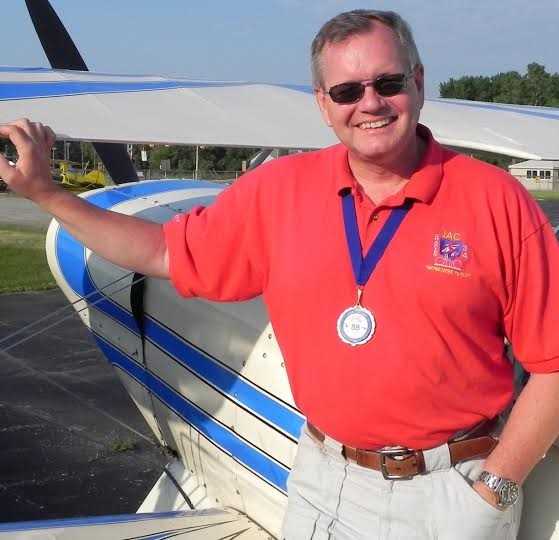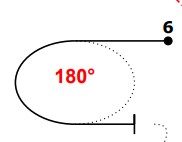 By Gordon Penner, IAC 429704
By Gordon Penner, IAC 429704
The Aerobatic Turn seems deceptively simple, but there is a lot of detail in it that is apparent to the judges' eyes if not done right. Please pay as much attention to this ‘simple’ maneuver as you do the other maneuvers.
First things first, most new people don’t hold enough bank angle in aerobatic turns. The judging criteria requires that the turn must be 60 degrees of bank minimum. Since you are flying for flawed human judges, they better not think you are shallow.
The pilot must also hold the angle of bank constant once it is set. Many times as a judge I have seen the bank bobbling as it is being set, and I’ve seen the bank changing during the pull to the new heading.
The book also requires observable pauses between the roll, the turn, and the rollout.
First, there must be a roll to the required bank without a change of heading. After pausing in this state long enough for the judges to see it, the pull to the new heading begins.
Many will ask me if they should be coordinated or uncoordinated. I say both. Then I get the funny looks. Let’s expand that, as it is one of the keys for flying it correctly for the judges.
You start the maneuver with a coordinated roll to the desired bank angle. However, to hold this bank and not have a change in heading the pitch control must be moved forward until no heading change is observed. But now the aircraft is sinking when the maneuver requires you to hold altitude. How do you fix that? Top rudder.
Let us say you are doing a left turn. At the pause between the roll and the pull you are now holding bank with the ailerons, holding heading with your forward pitch, and holding your altitude with your right rudder. Again, you are holding this state long enough for the judges to see it.
As you now begin the pull to your new heading you can be coordinated again, and you resume using your elevator to hold your altitude. Some modify this slightly.
When it comes to the elevator, during the heading change you are now holding between 2 to 3g’s if using enough back elevator to hold altitude at 60-70 degrees of bank. Simple physics. You are also reducing drag if you fly coordinated as opposed to uncoordinated.
Unfortunately, putting 2-3g’s on the airplane adds drag and the airplane slows down. Not good for the low horsepower/high drag airplanes.
Some sequences will have a slow roll after the turn. Some airplanes, like the Decathlon, do terrible slow rolls unless they have a decent amount of speed. Their low horsepower causes them to take a bit of time to get their speed back after spending some of it. Some airplanes, like the Citabria, can’t do the slow roll AT ALL unless they have a minimum of speed. How can we mitigate that?
Some will leave a small amount of top rudder in during the heading change, pulling less elevator. This makes for a bigger turn radius, but less g and less drag on the airplane. Unfortunately, flying uncoordinated in a slip is ‘draggier’ also.
The airplane will still descend slightly, and this must be hidden.
If the turn is flown away from the judges, a slight descent during the turn will probably not be seen.
The pilot must work out the trade-off between the drag of the g-load and the drag of sideslip. This will depend on their aircraft type and the demands of the aerobatic sequence. Usually, the drag from the g-load will be greater than that of the sideslip. If there is a spin after the turn, or a down-going maneuver after the turn, you could fly coordinated and pull to your hearts content!
At the finish of the turn there must be a pause between the finish of the turn and the rollout. You must go uncoordinated for a bit to hold this pause, then do a coordinated roll to wings level. Perform this ending pause the same way you flew the entry pause.
Also, the roll in and the roll out must be at the same roll rate. The rookie mistake is to roll in fast and roll out slow. You have less energy at the end of the roll, so the same aileron displacement done at the entry will yield a slower roll rate. This is fairly obvious in a lower performance aircraft.
So, you see, the ‘simple’ Aerobatic Turn is not so simple, eh?

Articles in the "2023 Sportsman Sequence" Series
Flying the 2023 Sportsman Sequence by Gordon Penner, In the Loop January 2023
Flying the Wedge by Gordon Penner, In the Loop February 2023
Flying the Immelman, by Gordon Penner, In the Loop March 2023
Flying the Loop, by Gordon Penner, Sport Aerobatics December 2019
Flying the Half Cuban, by Gordon Penner, In the Loop May 2023
Flying the Humpty Bump, by Gordon Penner, In the Loop June 2023
Flying the Competition Roll, by Gordon Penner, In the Loop July 2023
Flying the Hammerhead, by Gordon Penner, In the Loop August 2023
Flying the Spin, by Gordon Penner, In the Loop September 2023
Flying the Aerobatic Turn, by Gordon Penner, In the Loop October 2023
Online Resources:
Introduction to Aresti, by Brian Howard, www.iac.org/aerobatic-figures
More articles on typical Sportsman category figures
Half Cubans, Accurate 45-degree downlines, by Giles Henderson, Sport Aerobatics June 2011, pg. 28
A Roll is a Roll is a Roll...., by Gordon Penner, Sport Aerobatics, August 2008, pg. 16
Aerobatic Trim Part 1, by Gordon Penner, Sport Aerobatics September 2020
Aerobatic Trim Part 2, by Gordon Penner, In the Loop October 2020

